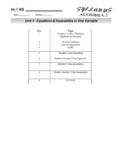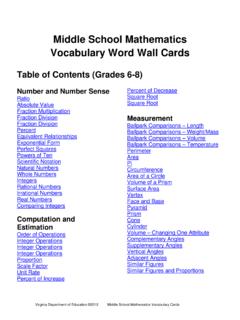Transcription of REAL NUMBERS - National Council Of Educational Research ...
1 (A) Main Concepts and Results Euclid s Division Lemma : Given two positive integers a and b, there exist uniqueintegers q and r satisfying a = bq + r, 0 r < b. Euclid s Division Algorithm to obtain the HCF of two positive integers, say c and d,c > 1 : Apply Euclid s division lemma to c and d, to find whole NUMBERS q and r,such that c = dq + r, 0 r < 2 : If r = 0, d is the HCF of c and d. If r 0, apply the division lemma tod and 3 : Continue the process till the remainder is zero. The divisor at this stagewill be the required HCF. Fundamental Theorem of Arithmetic : Every composite number can be expressedas a product of primes, and this expression (factorisation) is unique, apart from theorder in which the prime factors occur.
2 Let p be a prime number. If p divides a2, then p divides a, where a is a positiveinteger. 2, 3, 5 are irrational NUMBERS . The sum or difference of a rational and an irrational number is irrational. The product or quotient of a non-zero rational number and an irrational number isirrational. For any two positive integers a and b, HCF (a, b) LCM (a, b) = a NUMBERSCHAPTER 103/05/182 EXEMPLAR PROBLEMS Let x = pq, p and q are co-prime, be a rational number whose decimal expansionterminates. Then, the prime factorisation of q is of the form ; m, n arenon-negative integers.
3 Let x = pqbe a rational number such that the prime factorisation of q is not of theform ; m, n being non-negative integers. Then, x has a non-terminatingrepeating decimal expansion.(B) Multiple Choice QuestionsChoose the correct answer from the given four options:Sample Question 1 : The decimal expansion of the rational number willterminate after(A) one decimal place(B)two decimal places(C) three decimal places(D)more than 3 decimal placesSolution : Answer (B)Sample Question 2 : Euclid s division lemma states that for two positive integers aand b, there exist unique integers q and r such that a = bq + r, where r must satisfy(A) 1 < r < b(B)0 < r b(C) 0 r < b(D)0 < r < bSolution.
4 Answer (C)EXERCISE the correct answer from the given four options in the following some integer m, every even integer is of the form(A)m(B)m + 1(C)2m(D)2m + some integer q, every odd integer is of the form(A)q(B)q + 1(C)2q(D)2q + 103/05/18 real 1 is divisible by 8, if n is(A)an integer(B)a natural number(C)an odd integer(D)an even the HCF of 65 and 117 is expressible in the form 65m 117, then the value of m is(A)4(B)2(C)1(D) largest number which divides 70 and 125, leaving remainders 5 and 8,respectively, is(A)13(B)65(C)875(D) two positive integers a and b are written asa = x3y2 and b = xy3; x, y are prime NUMBERS , then HCF (a, b) is(A)xy(B)xy2(C)x3y3(D) two positive integers p and q can be expressed asp = ab2 and q = a3b.
5 A, b being prime NUMBERS , then LCM (p, q) is(A)ab(B)a2b2(C)a3b2 (D) product of a non-zero rational and an irrational number is(A)always irrational(B)always rational(C)rational or irrational(D) least number that is divisible by all the NUMBERS from 1 to 10 (both inclusive) is(A)10(B)100(C)504(D) decimal expansion of the rational number 145871250 will terminate after:(A)one decimal place(B)two decimal places(C)three decimal places(D)four decimal places(C) Short Answer Questions with ReasoningSample Question 1: The values of the remainder r, when a positive integer a isdivided by 3 are 0 and 1 only.
6 Justify your : PROBLEMSA ccording to Euclid s division lemma,a = 3q + r, where 0 r < 3and r is an integer. Therefore, the values of r can be 0, 1 or Question 2: Can the number 6n, n being a natural number, end with thedigit 5? Give : No, because 6n = (2 3)n = 2n 3n, so the only primes in the factorisationof 6n are 2 and 3, and not , it cannot end with the digit whether every positive integer can be of the form 4q + 2, where q is aninteger. Justify your The product of two consecutive positive integers is divisible by 2 . Is this statementtrue or false?
7 Give The product of three consecutive positive integers is divisible by 6 . Is this statementtrue or false ? Justify your whether the square of any positive integer can be of the form 3m + 2, wherem is a natural number. Justify your positive integer is of the form 3q + 1, q being a natural number. Can you write itssquare in any form other than 3m + 1, , 3m or 3m + 2 for some integer m? Justifyyour NUMBERS 525 and 3000 are both divisible only by 3, 5, 15, 25 and 75. What isHCF (525, 3000)? Justify your why 3 5 7 + 7 is a composite two NUMBERS have 18 as their HCF and 380 as their LCM?
8 Give actually performing the long division, find if 98710500 will have terminatingor non-terminating (repeating) decimal expansion. Give reasons for your rational number in its decimal expansion is What can you say aboutthe prime factors of q, when this number is expressed in the form pq? Give NUMBERS5(D) Short Answer QuestionsSample Question 1: Using Euclid s division algorithm, find which of the followingpairs of NUMBERS are co-prime:(i) 231, 396 (ii) 847, 2160 Solution : Let us find the HCF of each pair of NUMBERS .(i)396 = 231 1 + 165231 = 165 1 + 66165 = 66 2 + 3366 = 33 2 + 0 Therefore, HCF = 33.
9 Hence, NUMBERS are not co-prime.(ii)2160 = 847 2 + 466847 = 466 1 + 381466 = 381 1 + 85381 = 85 4 + 4185 = 41 2 + 341 = 3 13 + 23 = 2 1 + 12 = 1 2 + 0 Therefore, the HCF = 1. Hence, the NUMBERS are Question 2: Show that the square of an odd positive integer is of the form8m + 1, for some whole number : Any positive odd integer is of the form 2q + 1, where q is a whole , (2q + 1)2 = 4q2 + 4q + 1 = 4q (q + 1) + 1, (1) q (q + 1) is either 0 or even. So, it is 2m, where m is a whole , (2q + 1)2 = m + 1 = 8 m + 1.
10 [From (1)]Sample Question 3: Prove that 23+is : Let us suppose that 23+ is rational. Let 23+= a , where a PROBLEMST herefore, 2= 3a Squaring on both sides, we get 2 = a2 + 3 23aTherefore, 2132aa+=, which is a contradiction as the right hand side is a rationalnumber while 3 is irrational. Hence, 23+is that the square of any positive integer is either of the form 4q or 4q + 1 forsome integer that cube of any positive integer is of the form 4m, 4m + 1 or 4m + 3, forsome integer that the square of any positive integer cannot be of the form 5q + 2 or5q + 3 for any integer that the square of any positive integer cannot be of the form 6m + 2 or6m + 5 for any integer that the square of any odd integer is of the form 4q + 1, for some integer n is an odd integer.
















